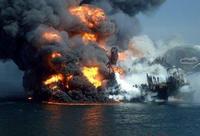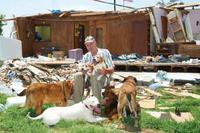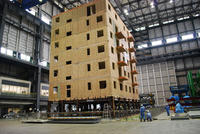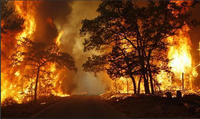-
Cost of a dirty bomb attack in L.A. would reach $16 billion

A dirty bomb attack on downtown Los Angeles’ financial district could severely affect the region’s economy at a cost nearly $16 billion, fueled primarily by psychological effects which could persist for a decade
-
-
Scientists: Deepwater Horizon exposed gaps in deepwater oil spill knowledge

On the second anniversary of the Deepwater Horizon oil spill in the Gulf of Mexico, a national team of scientists warns that inadequate knowledge about the effects of deepwater oil well blowouts threatens scientists’ ability to help manage comparable future events
-
-
Solar storms and infrastructure vulnerabilities

Space weather, and in particular coronal mass ejections, can cause huge disruption to many highly technological systems on Earth; experts say that vulnerable industries, such as power grids and airlines, should gather more information on space weather in order to make more informed decisions about how to deal with future solar storms
-
-
San Francisco earthquake planners developing pet-disaster response

San Francisco is preparing for the Big One in more ways than one: the latest addition to the city’s disaster preparedness plans is a legion of pet disaster responders, trained by city officials to rescue pet dogs, cats, rodents, birds, and reptiles in the event of a disaster, and transport them to one of 125 temporary shelters
-
-
California quake test shows promise of new building code

Researchers place a model hospital on a shake table to assess the structure’s ability to withstand earthquake; in accordance with California latest building code, base isolators, which are rubber bearings intended to absorb the shock of the motion, were installed underneath the structure; the hospital passed the 6.7-magnitude and 8.8-magnitude tests with flying colors
-
-
Industrial, materials industry facing risks on global scale
The struggling global economy and recent disasters, including the Thailand floods and Japan earthquake and tsunami, have forced the global industrial and materials industry to change the way it views and prioritizes resources for risk response
-
-
Direct drinking water recycling could prevent floods
The use of a more streamlined process to recycle wastewater could have saved Brisbane from severe flooding in 2011 and mitigated recent flood risks in NSW, a leading water expert says
-
-
April 2011 was one of the worst ever in terms of killer tornadoes
The month of April 2011 saw a historic outburst of 202 tornadoes which turned broad swaths of southeastern United States into a disaster zone; researchers believe that something called a “thermal boundary” set the stage for the birth of these killer storms
-
-
Scale of 2011 disasters challenged established thinking on nature of risk
New paper says that the scale of the catastrophes experienced in 2011 exceeded previous loss-modeling predictions and has challenged established thinking on the nature of risk; the paper says that, post-2011, companies need to re-examine their risk management strategies and introduce new methodologies to strengthen their operational and financial resilience
-
-
In environmental disasters, families experience conflict, denial, silence
Environmental disasters affect individuals and communities; they also affect how family members communicate with each other, sometimes in surprising ways; the researchers say that the findings were, in some ways, counterintuitive
-
-
Southern sea levels rise dramatically
Sea levels have risen about twenty centimeters in the South West Pacific since the late nineteenth century, a new scientific study shows
-
-
U.S. severe weather insurance losses breach $1.2 billion in March

The estimated economic loss of a series of natural disasters in the United States in March reached approximately $2.0 billion, while insured losses are expected to breach $1.1 billion amid more than 170,000 insurance claims
-
-
Missouri announces additional funding for Disaster Recovery Jobs Program
Missourigovernor announces an investment of $16.5 million in federal National Emergency Grant (NEG) funding to create temporary jobs for workers in twenty-nine Missouri counties affected by tornadoes, floods, and severe storms last year
-
-
Chinese monopoly on rare Earth metals a challenge for green economy
In order for clean technologies to contribute significantly to reducing greenhouse gases, the world would require an increase of neodymium and dysprosium – two of the seventeen rare Earth elements — of over 700 percent and 2,600 percent, respectively, in the next twenty-five years; the supply of these metals is currently increasing at 6 percent a year, and is under threat from China
-
-
The bicycle's next frontier: disaster response

Cities in seismically active regions are examining their emergency response policies in the wake of the March 2011 tsunami in Japan; the city of Portland, Oregon, as well as citizen-led Neighborhood Emergency Teams(NET), have been including the cargo bike in their emergency response plans
-
More headlines
The long view
Risk Assessment with Machine Learning
Researchers utilize geological survey data and machine learning algorithms for accurately predicting liquefaction risk in earthquake-prone areas.
